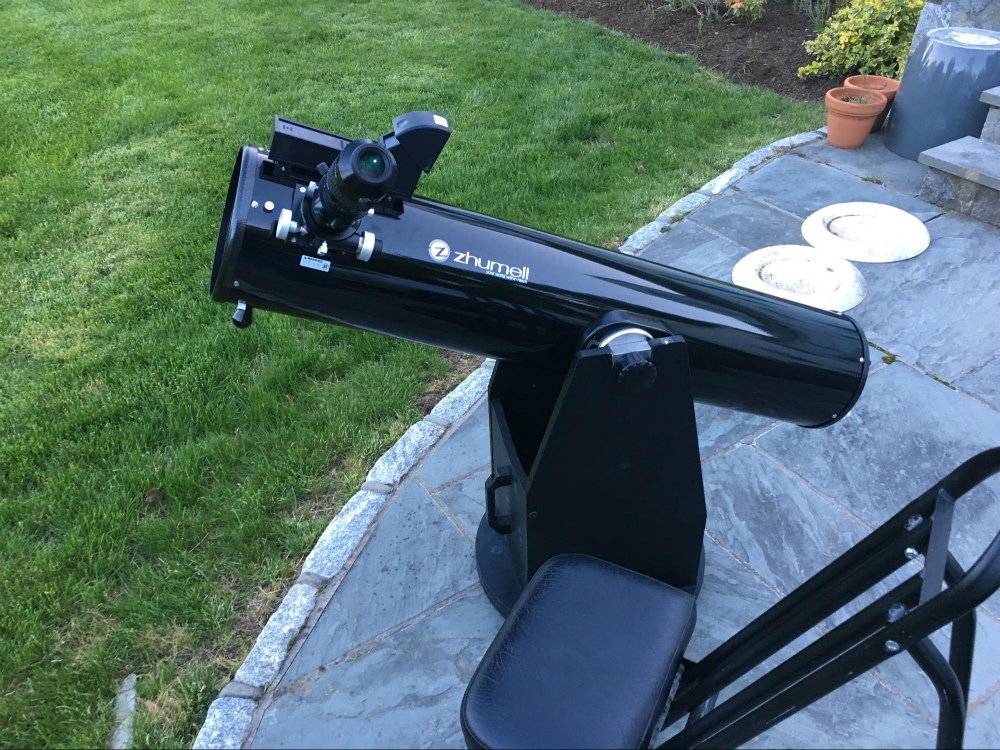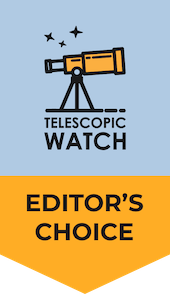The Z8 Optical Tube Overview
The Z8 is fairly standard in optical quality among all of the 8” Dobsonians out there (which is unsurprising since there are only two different OEMs for them). Some literature claims that the Z8 has enhanced reflectivity coatings with 94–96% reflectivity compared to the standard 89–93% reflectivity on most coatings, which would theoretically give it brighter images. A proper laboratory test would be required to be sure, as the effect would be negligible in observations.

The Z8’s mirror cell is collimatable and uses springs, but there are also three “mirror lock” bolts on the back. Supposedly, these are to compensate for any weakness in the springs, but the springs can handle the mirror just fine, and they could always be replaced if necessary. The mirror locks really just serve as a great way to get confused while collimating or break your mirror if you drop the scope (since the locking bolts directly contact the glass). Just remove them.
The Z8 has a built-in, DC-powered cooling fan that runs off a small battery pack supplied with the scope.
The Z8’s front cap is a bit of a weak point with this scope. It is not very tight-fitting, and there is nowhere to grab it from the middle. However, this is a minor inconvenience at most and can be solved with a trip to the hardware store for a cabinet knob and drilling a hole or two.
The tube of the Z8 is longer than that of some other 8” scopes on the market, such as the Synta-made Dobsonians marketed by Sky-Watcher (Classic Dobs), Orion (SkyQuest Series), and Bintel, among others. As such, it may not fit in the trunk or boot of some cars and must be laid across the backseat.
The Z8 comes with an extremely high-quality dual-speed Crayford focuser. This focuser (like all Crayfords) rolls the focuser drawtube against four rollers for precision and smooth motion. The dual-speed part comes from the fact that it has a 1:10 fine adjustment knob for precision focusing at high magnifications. It also uses a brass compression ring so as not to mar your eyepiece barrels (as does the included 1.25” adapter).
The Zhumell Z8 Accessories
The 9×50 right-angle correct image finder is decent but can be difficult to use. You have to sight along the barrel of the finder/telescope, then look into the finder itself to center your target. It’s best supplemented with or replaced by a zero-power reflex or red-dot sight.
The included laser collimator is really well made. However, the laser itself is frequently misaligned with the barrel, making it useless. This can be solved by making a makeshift V-block and adjusting the tiny Allen screws in the collimator – tricky but worth it.
The included 30mm SuperView is a decent low-power eyepiece based on the Erfle design. While there is some edge-of-field astigmatism, the 70-degree apparent field of view and the 40x magnification it provides with the Z8 make it great for low-power viewing of deep-sky objects. The included 9mm Plossl works okay, but you have to press your eyeball right up against it to see the entire field.
The “Moon filter” is little more than a piece of cheap green-tinted glass, not a true polarizing filter. It will dim the moon, but you probably don’t need it, and if you must have a moon filter, there are much higher-quality ones available.
A Better Dobsonian Mount Design
The Zhumell/GSO Dobsonians are a bit different from your typical Dob in their mountings, but the changes are at least somewhat for the better, if a bit strange compared to other offerings.
For one, the altitude bearings are far different from pretty much any other Dob. Instead of using Teflon pads, the Z8’s altitude bearings are ball bearings that can be adjusted for tension and can slide along the tube for balancing. You can achieve balance with some pretty heavy accessories on the front end as a result, but the balance tends to go out of whack if you switch from heavy to light eyepieces, which requires tightening the bearings and thus sub-optimal movement. Adjusting the center of gravity of the bearings requires tools and really can’t be done in the field.
Then there’s the azimuth bearing. Rather than Teflon on laminate, it’s a roller bearing, also known as a “lazy Susan,” which you might be familiar with on some furniture items. Many users swear by it. However, it is a bit loose and easy to spin compared to a normal Dobsonian bearing, which can be frustrating when trying to track at high power or on a windy night.
Like most mass-manufactured Dobs, the Z8’s mount assembles with just an Allen key and a handful of screws, a task that takes mere minutes to accomplish. It is, however, made of particle board, which is quite heavy and easily prone to moisture damage if the laminate covering peels off.
Should I buy a Used Zhumell Z8?
A used Z8 is a wonderful scope. Make sure the coatings on the mirrors are still good and the base isn’t damaged. If the base is damaged, replacing it is somewhat expensive, but you can easily make a sturdier, lighter, and longer-lasting one out of plywood with just a few tools if you are so inclined.
Alternative Recommendations
The Z8 and its sister, the Apertura AD8 are our favorite telescopes in their price range, but here are some alternatives we’ve selected for your convenience.
Under £600
- The Explore Scientific 10” Hybrid Dobsonian will give you slightly brighter images and more resolving power than the Z8, for a slightly lower price. However, the stock telescope has some minor mechanical issues and there’s no dual-speed focuser or even a usable set of eyepieces, along with a poor quality red dot finder that essentially does not function out of the box. The truss is also less convenient to assemble in the field.
- The Sky-Watcher Virtuoso GTi 150P has less aperture than the Z8, but has full motorized tracking and GoTo controlled by your smart device (phone/tablet), a compact tabletop mount and collapsible tube that can fit in a backpack, and can be used manually if you desire. The manual Heritage 150P is identical to the GTi 150P apart from the lack of electronics.
- The Orion SkyQuest XT8 is essentially a minimal 8” Dobsonian without the dual-speed focuser or accessory kit that makes the Z8 such a bargain – just a single-speed 2” Crayford, one low power eyepiece, and a red dot finder. Upgrading will cost more than the price difference between the XT8 and Z8, however….
£600-£800
- The Apertura AD10/Zhumell Z10/Orion SkyLine 10 offers the same great features, accessories, and a similar form factor to the Z8, just with an aperture boost offering 36% more light gathering ability and 25% more resolving power, at the same focal length and with a minimal increase in weight or volume.
- The Celestron StarSense Explorer 8” Dobsonian is a pretty stripped-down scope – as with the Orion SkyQuest XT8, you only get one eyepiece, a red dot finder, and a single-speed Crayford focuser. However, it offers Celestron’s StarSense Explorer technology and phone dock to make it easy to locate objects in the night sky with the assistance of your smartphone.
- The Sky-Watcher 8” FlexTube Dobsonian has a collapsible tube, making it slightly more portable (though no lighter in weight) than a conventional 8” Dobsonian, and a usable set of accessories is provided along with a single-speed 2” Crayford focuser.
Aftermarket Accessory Recommendations
The Z8 comes with a lot of great accessories, but we’d still recommend a few more things to go with it.
For one, we highly recommend the 6mm Goldline eyepiece, such as the one sold by SVBONY. This will provide 200x magnification, a bit better for the Moon, planets, and double stars than the 133x provided by the included 9mm eyepiece.
Additionally, a zero-power reflex sight is a good idea. The Telrad or Rigel Quikfinder are both great choices. The Telrad is bigger but runs off standard AA batteries and is a bit easier to use, while the Rigel is compact and has a built-in dew shield.
The last is some kind of nebula filter. An ultra-high contrast, or UHC filter is best; it cuts out almost all the light entering the eyepiece apart from the oxygen-III, hydrogen-alpha, and hydrogen-beta spectra emitted by the glowing ionized gases in nebulae. Even though it doesn’t get rid of the effects of light pollution, a UHC makes it easier to see nebulae from places with a lot of light pollution. It also helps bring out contrast even in places with dark skies. We recommend the 2” Orion UltraBlock for this purpose.
What can you see with the Zhumell Z8?
The Z8 can show you a lot of stuff. You’ll be able to see Saturn’s rings, Jupiter’s cloud belts, the numerous moons of both gas giants, and, of course, the Great Red Spot. On a good night, you can see some cloud details on Saturn and the Cassini Division in its rings too. Mars’ dark spots and ice caps, along with any dust storms, can be seen when the Red Planet is close to Earth. Venus and Mercury don’t show much besides their phases in any telescope, but they are usually quite sharp and pleasing to look at with the Z8 on a clear and steady night. Uranus and Neptune are pale bluish dots, but under dark skies, you might be able to spot their moons (which are nearly as faint as Pluto): Oberon and Titania around Uranus, and Triton around Neptune. The moon looks fabulous too. Pluto could be reached under ideal conditions, but it would be a very dim star-like point that would be hard to find.
Outside the Solar System, what the Z8 can show you really depends on the quality of your skies. Under dark skies, you’ll be able to see details and structure in numerous spiral and irregular galaxies like M31, M51, M33, M82, and the Virgo Cluster of galaxies. The handful of emission nebulae like Orion, the Lagoon, and the Swan look fantastic, especially with that oh-so-handy nebula filter we recommend, which helps with enhancing their contrast against the background (though even unfiltered, they’re lovely). Planetary nebulae vary quite a bit; some, like the Dumbbell and Helix, are huge, colorless, and really benefit from a nebula filter, while smaller ones, like the Cat’s Eye, are beautiful green or blue in color and have a small-scale structure that benefits from using very high magnification. You’ll also have no trouble resolving many of the brighter globular clusters like M13 or M15 into individual stars, and many open clusters are colorful and splendid even under light-polluted skies. Keep in mind that galaxies and larger nebulae will nearly vanish or at least be


